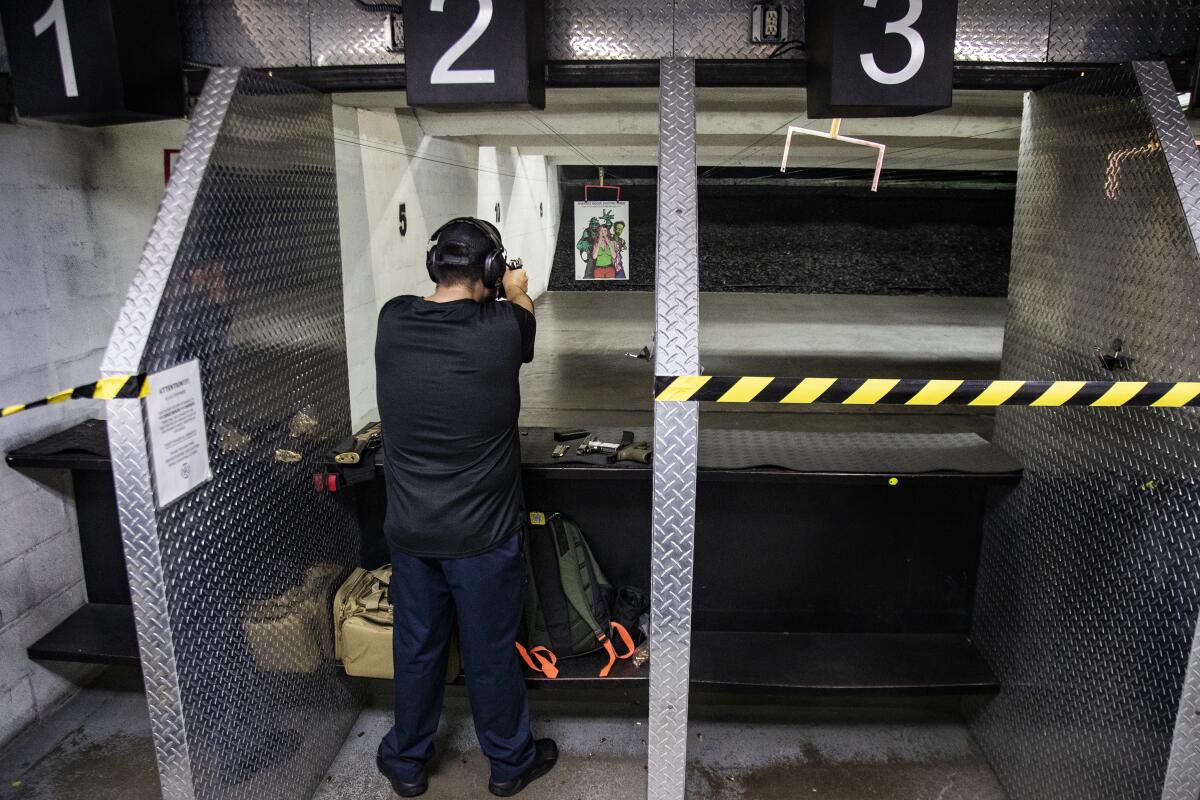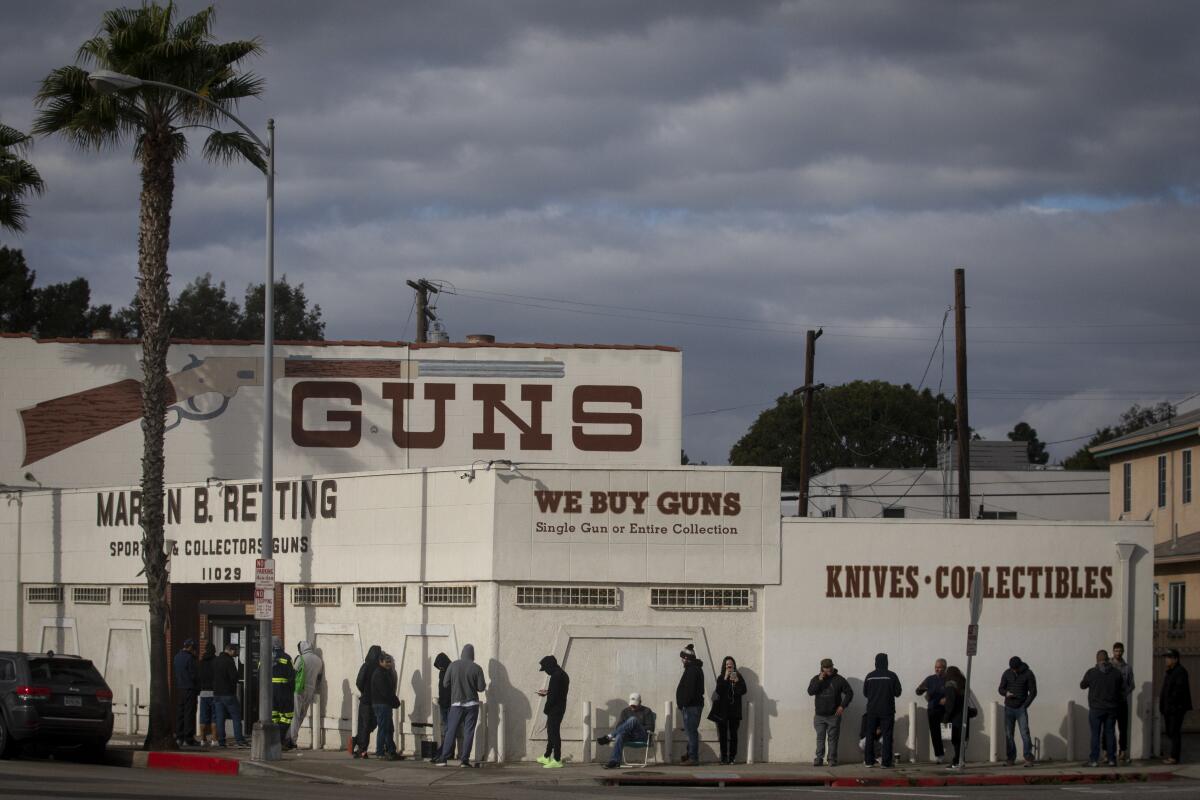About 110,000 Californians have bought a gun since the coronavirus arrived, study says

- Share via
In the first five months of the COVID-19 pandemic, thousands of Californians bought new guns and changed the way they stored their firearms in a bid to counter the unrest, government crackdowns and societal disintegration they feared would be unleashed by the public health emergency, a new survey has found.
The UC Davis researchers who conducted the survey detected shifts in gun ownership trends that they said are likely to drive an uptick in firearm-related injuries and deaths, including suicides and the consequences of accidental discharges.
By mid-July, the pandemic was cited as a factor in the purchase of an estimated 110,000 new firearms in the state, they reported.
The majority of those sales, 57%, were to people who already owned at least one gun.
But with 43% of sales going to people who did not previously own a firearm, the pandemic has helped spur the creation of as many as 47,300 new gun-owning households in the state, the UC Davis team reported this month to MedRxiv, a website where researchers share their preliminary work. Many of those are homes that include children, teens and others at risk of self-injury, they added.
The California Safety and Wellbeing Survey was given to 2,870 Californians selected to serve as a representative sample of the state’s adult population. Its questions were designed to capture what they were thinking and doing in response to the pandemic and a political climate roiled by a string of police killings of Black men and women.
Their responses mirror a nationwide spike in gun sales. An earlier study by some of the same researchers found that firearm sales in the U.S. surged 64% between March and May. The result: An additional 2.1 million firearms entered the homes of private citizens in the United States.
The doctors who lead the medical profession’s debates on how best to preserve and restore our health are done with moments of silence in the face of gun-related violence.
Those estimates are backed up by figures from the National Shooting Sports Foundation. Based on the FBI background checks required for the sale of most firearms, the trade association for the firearms industry said that nearly 5 million Americans purchased a firearm for the first time in the first seven months of 2020, accounting for 40% of all firearms sales in that period.
The UC Davis researchers, from the school’s Violence Prevention Research Program, found that the fears driving the surge in gun sales bespeak a nation suffering a potentially serious crisis of confidence.
When asked what concerns had factored into their purchases, 76% of recent gun buyers who cited the pandemic said they worried about lawlessness. More than half, 56%, said they were concerned about the release of prisoners as a result of coronavirus outbreaks behind bars. In addition, 49% said they were worried about the government “going too far” and 38% feared a “government collapse.”

When asked how they stored their weapons and whether those habits had changed in recent months, 1.2% of gun owners said the pandemic had prompted them to keep at least one firearm loaded and at the ready — not stored securely or locked in a safe or rack.
Considering that just over 4 million Californians own guns, that finding suggests that roughly 55,000 additional households now have a loaded firearm within reach of unauthorized users. About half of those who acknowledged such a switch lived in homes with children or teens.
Finally, the survey results painted a worrisome picture of the state and its residents. Among those surveyed, 13.3% said they knew someone who might physically hurt themselves on purpose — and 7.5% of those respondents said the person they were thinking of had suffered a pandemic-related loss.
In California, suicides represent almost 55% of the state’s gun-related fatalities. Some 1,629 suicides were carried out with a firearm in 2018, the most recent year for which statistics are available.
“It’s important to understand that the impacts of the pandemic have been much broader than the transmission of disease,” said David Studdert, a public health expert at Stanford whose research focuses on guns and suicide.
“This increased sale of guns, the anxieties that drive it, and owners’ behavior around guns — those are among the pandemic’s many shadow effects. This study starts to identify those,” added Studdert, who was not involved with the survey.
Johns Hopkins University injury prevention expert Daniel W. Webster called the apparent creation of new gun-owning households “surprising and concerning.”
In a country where about 118 million households include a gun, the addition of another 43,000 may seem trivial. But “it’s the combination of COVID-related stress, fear and despair along with increased gun ownership that is most concerning,” said Webster, who was not involved in the survey either.
Drawing a link between firearms and a pandemic may seem like a stretch. But the UC Davis researchers make clear that, against the backdrop of a national emergency, each trend observed — an increase in the number of guns in circulation, the establishment of new gun-owning households and the relaxation of many households’ safe-storage practices — is likely to boost the risk of gun-related accidents, suicides and violence. Their cumulative effect could be hard to predict.
Congressionally mandated funding restrictions effectively shut down gun research for more than a decade. But the fact that firearms purchases surge in the wake of national emergencies is widely accepted.
One often-overlooked fact about mass shootings is that they have been very good for the gun business.
In the five months after the 2012 Sandy Hook shootings in Newtown, Conn., for instance, the legal purchase of firearms jumped by roughly 3 million over usual sales. Gun sales routinely rise after mass shootings and after elections in which gun-rights candidates have been beaten by politicians who favor tighter strictures on guns.
The effects of those additional purchases are more hotly debated.
Multiple studies have linked the density of gun-owning households in counties, states and countries to the incidence of gun-related injuries and death. People with ready access to a firearm are almost twice as likely to be killed and three times more likely to commit suicide than those without such access, according to a 2014 study in Annals of Internal Medicine.
The researchers who tallied the post-Sandy Hook sales surge also found that accidental firearm deaths of children rose in tandem with that sales hike. The increases in those child deaths occurred in places where gun sales increased the most.
Such findings fall short of establishing a cause-and-effect relationship between gun ownership and injury risk. But they are suggestive.
A comprehensive 2018 report by Rand Corp.’s Gun Policy in America project said the link was “sufficiently compelling” to lead to the assumption that “gun availability does increase the risk of suicide.”







